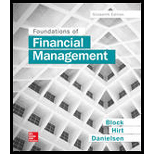
a.
To calculate: Net proceeds to Tyson Iron Works.
Introduction:
Net Proceeds:
It is the amount received by the seller of shares after the deduction of all the expenses and costs incurred for making such sales.
a.
Answer to Problem 20P
The net proceeds on the sale of shares to Tyson Iron Works is $11,845,000.
Explanation of Solution
Calculation of net proceeds:
Working Notes:
Calculation of net price:
Calculation of proceeds before out-of-pocket expenses:
b.
To calculate: The EPS of Tyson Iron Works immediately prior to the issue of stock.
Introduction:
Earnings per share (EPS):
It is the profit earned by shareholders on each share. A higher EPS indicates a higher value of the company because investors are ready to pay a higher price for one share of the company.
b.
Answer to Problem 20P
The EPS of Tyson Iron Works immediately prior to the issue of stock is $1.05.
Explanation of Solution
Calculation of the EPS immediately prior to the issue of stock:
c.
To calculate: The EPS of Tyson Iron Works immediately post the issue of stock.
Introduction:
Earnings per share (EPS):
It is the profit earned by shareholders on each share. A higher EPS indicates a higher value of the company because investors are ready to pay a higher price for one share of the company.
c.
Answer to Problem 20P
The EPS of Tyson Iron Works immediately post the issue of stock is $0.94.
Explanation of Solution
Calculation of the EPS immediately post the issue of stock:
d.
To determine: The
Introduction:
Rate of Return (ROR):
A measurement of the
d.
Answer to Problem 20P
The ROR that must be earned to prevent any dilution in an EPS of $1.05 is 4.52%.
Explanation of Solution
The calculation of ROR without the dilution of EPS is shown below.
Hence, 4.52% is the rate of return required to be earned on the net proceeds to earn an EPS of $1.05.
Working Notes:
Calculation of incremental earnings:
Calculation of earnings:
e.
To determine: The rate of return that must be earned by Tyson Iron Works on its proceeds to earn a 10% increase in its EPS during the year it went public.
Introduction:
Rate of Return (ROR):
A measurement of the profit earned or loss incurred on an investment over a specific time-period is the ROR. It compares the gain/loss to the costs incurred on the initial investment.
e.
Answer to Problem 20P
The ROR that must be earned to earn an increase of 10% in EPS is 8.88%.
Explanation of Solution
The calculation of ROR to earn an increase of 10% in EPS is shown below.
Hence, 8.88% is the rate of return required to be earned on the net proceeds to earn an increase of 10% in the EPS.
Working Notes:
Calculation of incremental earnings:
Calculation of earnings with a 10% increase:
Want to see more full solutions like this?
Chapter 15 Solutions
Foundations of Financial Management
- Which of the following would be expected to hold its value best during a time of inflation? A certificate of deposit. A corporate bond. A house.arrow_forwardWhat is a budget? A spending plan showing sources and uses of income. A limit on spending that cannot be exceeded. The amount of money that a credit card will let youarrow_forwardThe Pan American Bottling Co. is considering the purchase of a new machine that would increase the speed of bottling and save money. The net cost of this machine is $60,000. The annual cash flows have the following projections: Year 1 ........... 2 ........... 3 ........... 4 ........... 5 ........... Cash Flow $23,000 26,000 29,000 15,000 8,000 a. If the cost of capital is 13 percent, what is the net present value of selecting a new machine? I need to see the work. I can't use Excel to solve the problem. Excel doesn't help me solve Part a.arrow_forward
- Pat and Chris have identical interest-bearing bank accounts that pay them $15 interest per year. Pat leaves the $15 in the account each year, while Chris takes the $15 home to a jar and never spends any of it. After five years, who has more money? Pat. Chris. They both have the same amount. Don’t knowarrow_forwardAssume a firm has earnings before depreciation and taxes of $200,000 and no depreciation. It is in a 25 percent tax bracket. a. Compute its cash flow using the following format: Earnings before depreciation and taxes _____Depreciation _____Earnings before taxes _____Taxes @ 25% _____Earnings after taxes _____Depreciation _____Cash Flow _____ b. Compute the cash flow for the company if depreciation is $200,000. Earnings before depreciation and taxes _____Depreciation _____Earnings before taxes _____Taxes @ 25% _____Earnings after taxes _____Depreciation _____Cash Flow _____ c. How large a cash flow benefit did the depreciation provide?arrow_forwardAssume a $40,000 investment and the following cash flows for two alternatives. Year Investment X Investment Y 1 $6,000 $15,000 2 8,000 20,000 3 9,000 10,000 4 17,000 — 5 20,000 — Which of the alternatives would you select under the payback method?arrow_forward
- The Short-Line Railroad is considering a $140,000 investment in either of two companies. The cashflows are as follows:Year Electric Co. Water Works1.................. $85,000 $30,0002.................. 25,000 25,0003.................. 30,000 85,0004–10............ 10,000 10,000a. Using the payback method, what will the decision be?b. Using the Net Present Value method, which is the better project? The discount rate is 10%.arrow_forwardWhat is corporate finance explain its important?arrow_forwardWhat is corporate finance? can you explain more?arrow_forward
- General accounting problem.arrow_forwardWhat do you know about corporate finance? tell me about thisarrow_forwardWhich of the following is the primary function of insurance? Making risk disappear. Pooling and sharing risk among the insured. Making someone else pay for an accident or loss. Don’t know.arrow_forward
 Intermediate Financial Management (MindTap Course...FinanceISBN:9781337395083Author:Eugene F. Brigham, Phillip R. DavesPublisher:Cengage Learning
Intermediate Financial Management (MindTap Course...FinanceISBN:9781337395083Author:Eugene F. Brigham, Phillip R. DavesPublisher:Cengage Learning EBK CONTEMPORARY FINANCIAL MANAGEMENTFinanceISBN:9781337514835Author:MOYERPublisher:CENGAGE LEARNING - CONSIGNMENT
EBK CONTEMPORARY FINANCIAL MANAGEMENTFinanceISBN:9781337514835Author:MOYERPublisher:CENGAGE LEARNING - CONSIGNMENT

